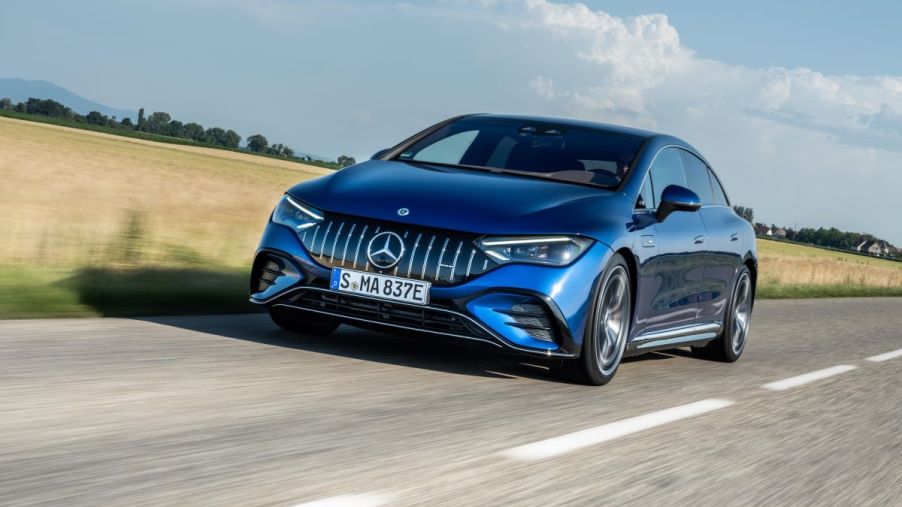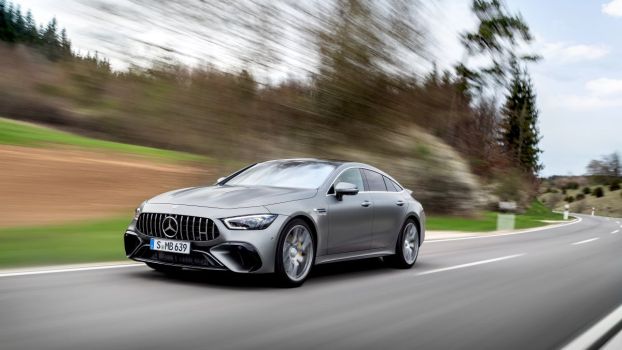
Real World Test: Mercedes-AMG EQE vs the AMG E63 S
The 2023 Mercedes-AMG EQE and Mercedes-AMG E63 S are both the ultimate expressions of performance among the Tri-Star brand’s mid-size sedans. They have similar performance, power, price points, and practicality but deliver driving thrills and luxe cruising in entirely different ways. The Mercedes-Benz E63 S bears the flag of convention with traditional styling and a roaring, twin-turbo V8 under the hood. The AMG EQE represents the future of the sportiest Mercedes models with its all-electric powertrain and slippery styling. So, if you have around $115,000 burning a hole in your pocket, which is the better choice?
I recently spent a week behind the wheel of the 2023 AMG EQE and spent several hundred miles piloting the 2021 E63 S — as there was no 2022 model available in the U.S., and there haven’t been any significant changes to the 2023 model. Choosing which of these performance E-Class-branded models I’d rather put in my driveway (you know, if I could actually afford to) isn’t so easy.
The Mercedes-AMG EQE and E63 S deliver serious power
Whether their power comes from electricity or controlled explosions, the Mercecdes-AMG EQE and Mercedes-AMG E63 S pay it in spades.
The E63 S is motivated by AMG’s venerable 4.0-liter, twin-turbo V8 and cranks out 608 horsepower and 627 lb-ft of torque. The AMG EQE uses dual electric motors to develop 617 hp and 701 lb-ft of torque, but an available package will up those figures to 677 and 738, respectively, in short bursts.
The E63 S, with its sonorous V8 soundtrack, roars out of the gate and will hustle from 0-60 mph in just 3 seconds. As expected with its internal combustion engine, there is a slight delay in power delivery on throttle tip-in, but that moment is about as short as the time it takes for the 63 S to reach the horizon. It is ferociously quick from just about any speed. However, its acceleration feels almost pedestrian compared to the EQE.
The electric EQE takes just slightly less time to get itself from 0-60 mph, 2.8 seconds, but its power transfer is simply staggering — it’s instantaneous. Put your right foot down hard in Sport+ mode, and the initial thrust is so violent it makes your vision go wobbly. Then again, that could be from its brutal grunt slamming your head so deep into the headrest you’re likely to leave an indentation. In my five years of testing cars for a living, nothing comes to close to the sheer brutality of the EQE’s acceleration.
So, what happens when the road goes twisty?
The E63 S shines in the corners
Both models have plenty of tuning and upgrades to help them carve corners with the precision of a well-honed chef’s knife, but the EQE’s weight does hold it back. It weighs a full half-ton more than the E63 S, and you can feel that added bulk. That’s not to say it isn’t quick. In fact, the grip levels offered from the tuned suspension and chassis, coupled with Pirelli P Zero PZ4 rubber, are hugely impressive, given the AMG EQE’s heavyweight status.
The E63 S feels far nimbler, and it seemingly rides through corners on rails with the poise allowing drivers to take full advantage of its 603 ponies.
Either model offers serious smiles per mile in the bends, but on a curvy mountain road, I’d take the E63 S for its better athleticism — and enjoy listening to its V8 roar bounce off the trees.
The AMG EQE is a better cruiser
As the father of a four-year-old whose favorite hobbies are talking for hours on end without inhaling and pummeling me, I highly value moments of quiet and comfort, and the EQE delivers the brief respite I crave. Its cabin could seemingly double as a sound deprivation chamber, and it feels slightly softer sprung than the 63 S over road imperfections. The flowing ambient interior lighting, massaging front seats, and minimalistic but attractive interior styling only add to the serenity of cruising in the EQE.
Which Mercedes-Benz AMG model is easier to live with?
The everyday livability of the Mercedes-AMG EQE and Mercedes-AMG E63 S is a mixed bag.
For instance, the EQE is slightly more spacious for hauling groceries, but its low greenhouse meant I hit my head on its doorframes more than I’d like to admit. The EQE’s outward visibility also suffers greatly due to its sleek shape. I had no issues turning out of oblique junctions in the E63 S, whereas, in the EQE, they’re practically acts of faith.
I also vastly prefer the physical knobs and buttons of the E63 S. The EQE is almost entirely dependent on touchscreen inputs, and there are seemingly endless menus to navigate. However, I do appreciate the cleaner appearance of the EQE’s setup.
Of course, there is also the elephant in the room — gasoline versus electricity. The E63 S chugs premium fuel as if it were on the second day of a week-long bender, and those bills will stack up quickly.
The EQE needs no such fill-ups, but its range is limited to 225 miles. Standard DC fast charging at up to 170 kW can re-juice the batteries quickly, but there are no such chargers conveniently placed near my home or office (also my home). The EQE has several regenerative braking settings, and the most aggressive appeared to help it significantly retain and regain lost charge. Still, not enough to make up for all the times I floored the throttle to experience its ridiculous acceleration.
Is the Mercedes-AMG EQE or Mercedes-AMG E63 S better overall?
The Mercedes-AMG EQE and Mercedes-AMG E63 S are both excellent ultra-sporty sedans that deliver serious driving pleasure. I’d be happy to put either in my garage. However, in the battle of tradition versus technology, I’d opt for the E63 S.
The AMG EQE is a wonderful performance EV. It is a technology showcase, its acceleration is mind-boggling, it’s still a hell of a performer when the tarmac goes twisty, and its sumptuous and whisper-quiet cabin is practically unbeatable for the daily commute.
Ultimately though, the AMG EQE just doesn’t deliver the same wow factor as the E63 S. The 63 S is a vast departure from the standard E-Class in its performance, looks, and noise. It provides the visceral experience that enthusiasts crave.
Meanwhile, the AMG EQE’s half-a-boiled-egg appearance doesn’t excite. Additionally, there’s no soundtrack to get your heart pumping when you chase the figurative red line. Its athleticism is hugely commendable, but at the end of the day, it still just feels like an ultra-powerful electric sedan, not something that genuinely stirs the soul.
To put it one way, I walked away from the E63 S wanting nothing more than to actually put one in my garage. After testing the AMG EQE, I commended it and lauded its performance, but it lacked that got-to-have-one factor.
AMG is still figuring out how it will set its models apart as Mercedes-Benz drives into its electrified era, and its EQE model is a fantastic foundation. However, the in-house tuner still appears to be determining its future direction in the EV segment. For now, the E63 S, which coincidentally is in its last year of production, represents the pinnacle of decades of AMG’s bread and butter. That’s why, at least for now, I’d rather have the E63 S.




